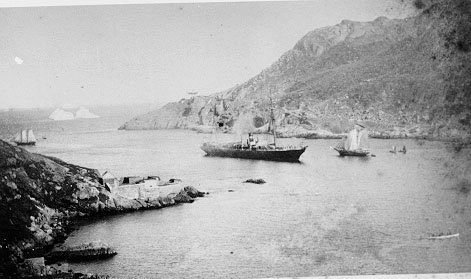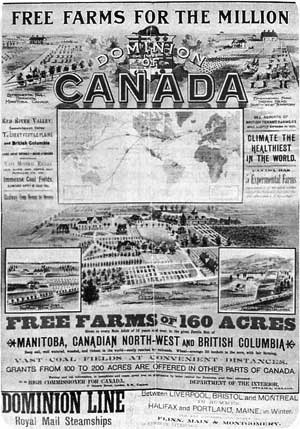Immigrants to Canada: The Ukrainians (from c1892-1914)
Immigrants to Canada: The Ukrainians (from c1892-1914)
Link to Leon Sawicki main page
Link to Joseph Sawicki, Leon’s father.
Link to Jesmer Family History page.


Most of this information is from Early Ukrainian Settlements in Canada 1895-1900 by Vladimir J. Kaye, (Toronto: University of Toronto Press, 1964) and Canada’s Ukrainians Negotiating an Identity edited by Lubomyr Luciuk and Stelkla Hryniuk, (Toronto: University of Toronto Press, 1991).
There appears to be a great deal of confusion describing the Ukrainian settler. Some of these people came from Galicia, which was part of the Austro-Hungarian Empire. Others came from the Kiev area as well as several other places. They were often described in early emigration records as Austrians, Galicians, Bukowinians, Ruthenians, Little Russians, Routhainians, and Gallatians. The problem appears to be one of political-geographical designations versus ethnic designations. Kaye describes this problem in his book noting that, “If the diverse nomenclature of the Ukrainian ethnic group caused confusion of opinion during the 1930’s, it was a veritable enigma to Canadian officials during the 1890’s.”p. xxiv
Although there were some Ukrainian settlers in Canada in 1892, the larger migration took place between 1897-99. The 1892 settlers were mainly from the village of Nebyliw in the district of Kalush. They settled in Edna, Alberta (then called the North West Territories). The town was later renamed Star. Kaye lists many of these early settlers in his book.
A chapter in Canada’s Ukrainians Negotiating an Identity, is called “Peopling the Prairies” and this is indeed what the Ukrainians did. They settled in Manitoba in the areas of Dauphin, Shoal Lake, Stuartburn, Whitemouth, Cooks Creek, Inter Lake, St. Norbert and Winnipeg; in Saskatchewan they choose the Prince Albert, Fish Creek and Yorkton areas; in Alberta is was Star and Leduc. These settlers moved, often from farms as small as a few acres to quarter-sections of 160 acres. Some did choose to stay in urban areas but the majority went on the land.
In 1895, Dr. Josef Oleskow, of Galizien, Austria, wrote to the Canadian Department of the Interior, which was responsible for immigration. Dr. Oleskow wrote: “A great number of Galician agriculturists of Ruthenian (Slavic) nationality desire to quit their native country, due to over-population, subdivision of land holdings, heavy taxation, and unfavourable political conditions.” Oleskow stated that they were also looking at Brazil as a possible new home. (Many Ukrainians did migrate to Brazil.)
Dr. Oleskow asked the government for information on the establishment of homesteads in Manitoba, Ontario, Alberta, Saskatchewan, Assiniboia, and possibly British Columbia. For some months the letters continued and Dr. Oleskow paid a visit to Canada sailing on the 1st of August, 1895, from Liverpool on the SS Sardinian. The result of all of this was that several parties of Ukrainians made their way to Canada.
However, there were still a few problems to solve. The Austrian Government was not pleased with the exodus of the Ukrainians. “The Select Committee of the Galician Diet appointed to investigate the emigration movement, the spread of which in that province has formed the subject of repeated discussion of late, has now placed a resolution before the Diet recommending that energetic measures should be adopted by the provincial authorities in conjunction with the Government to suppress those injurious influences which are calculated to increase the exodus.” [p. 56 of Kaye]
In 1896 a letter was sent to the Department of the Interior stating, “I have the honour to inform the Department that besides a small group of our emigrants I send a group of circa 30 families (farmers) to Canada who will leave Hamburg at April 11 or perhaps March 25th. They are booked by Spiro & Co.” [p. 57 of Kaye]
They sailed on a Hansa Steamer on April 11, 1896 and on April 30 a wire arrived in Ottawa stating that the families were on board the SS Christiania heading for Quebec. They were called “Austrians”. The report states, “Oleskow party one hundred seven leave by regular train tonight…”[p. 60 and p. 181 of Kaye] (A list of many of these passengers are in Kaye’s book.)
In 1897, Dr. Oleskow organized several parties for departure to Canada. They came from Galicia and Bukowina with the first party again being booked by Spiro & Co. on the Hansa Line steamer the SSArcadia which arrived at Quebec on May 2, with 648 persons. The SS Scotia arrived at Halifax on May 3 with 435 settlers on April 30, 1897. The emigrants on the Scotia were not very well off and the government wanted to discourage what it called “pauper immigrants.” The Immigration Agent at Montreal complained in May of 1897 about the “exorbitant prices” which these new immigrants were changed for supplies upon landing there. [p.95, p. 105 and 189 of Kaye.]
Kaye mentions several other vessels. They were:
- the Sicilia from Hamburg arrived in Quebec July 22, 1896[p. 137]
- SS Arabia with 558 Galicians in 1897 from Hamburg on May 8 [p. 161, p. 168 and p. 280]
- SS Armenia with 717 in 1897 from Hamburg [p. 169 and p. 249]
- SS Palatia just after the Armenia with 569 souls from Hamburg [p. 249]
- SS Hispania 1897[p. 169]
- SS Arcadia 1897 [pp. 192-5]
- SS Prussia, of Hamburg, arrived May 27, 1897 at Quebec with 672 passengers [p161, p. 168, pp. 195-8, pp. 322-3];
- SS Labrador in February, 1897 with 140 passengers [p. 168]
- SS Scotsman with 42 passengers in March, 1897
- another party of Galicians, some 931 in number, left Hamburg on April 10, 1898, sailing for Halifax. [p. 105];
- SS Cos [p. 118];
- SS Italia to Halifax with 738 on June 6, 1898; [p. 325];
- “four Hamburg-America Liners will land in Halifax in April and May[1899].” with more Galicians and Hungarians [p. 123];
In a government communication of December 20, 1898 it states that some 10,000 Ukrainians had arrived in Canada in the last two years. By 1914 over 150,000 would make their way to Canada.
https://personal.uwaterloo.ca/marj/genealogy/ukrainian.html






Interact with us using Facebook